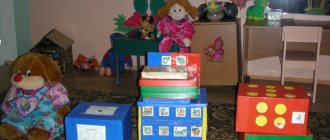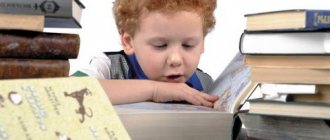Games and exercises with vowel sounds are very important for practicing the strong, smooth and long exhalation necessary in working on sound pronunciation; they are the foundation on which all work on the development of phonemic processes and prosody is based.
You can start training speech breathing itself only after the child has formed a strong, smooth exhalation.
Singing vowel sounds with movements
All vowel sounds [a], [u], [o], [i], [e], [s] are sung while exhaling.
- “The flower is blooming” - [a]. Starting position – standing, arms down. Raise your arms up through your sides – inhale. Hands down to the sides, we sing: “A-a-a - exhale.
- “Chopping wood” - [y]. Starting position – standing, arms down. Legs wider than shoulders. Straight arms up – inhale. Bend over and sing: “U-oo-oo.”
- “Let’s let go of a cloud” - [o]. Starting position – standing, arms down. Hands to the sides - inhale. The arms are joined, the hands are folded. Drawing the letter O, move forward – exhale.
- “Keeping a big ball” - [e]. Starting position – standing, arms down. Hands to the sides - inhale. Hands in front of the chest - exhale: “Uh-uh.”
- “Pendulum” – [s]. Starting position – standing, arms down. Straight arms with clenched fists forward - inhale. Straight arms with clenched fists are pulled back - exhale: “s-s-s.”
- “Catch the ray” [and]. Starting position – standing, arms down – inhale. Hands smoothly rise up - exhale: “E-and-and.”
Singing vowels and their combinations with varying strength and pitch
The strength of the voice is proportional to the direction of movement of the hand. As the hand moves up (“uphill”), the strength of the voice increases, and as the hand moves down (“downhill”), it decreases. With horizontal movement of the hand, the strength of the voice is constant. Children measure the strength of their voice and sing a given sound softer or louder in an even voice, relying on visual material.
Guessing and pronouncing vowel sounds using appropriate movements
Sound [a] - clap hands in front of the chest, sound [i] above the head, sound [o] - on the knees, sound [u] - hitting fist against fist (horizontally), sound [e] - with the backs of the hands touching each other , sound [s] - blow with fist on fist (vertically). It is offered for guessing series corresponding to 3-4 sounds (3-4) of the series.
Ball games to reinforce the pronunciation of vowel sounds and develop smooth, strong exhalations
Game “My ball and I sing vowel sounds together”
An adult offers to sing a given sound while simultaneously rolling a ball on the floor or a ball on the table. The child takes a breath and smoothly rolls the ball to the adult: Ah-ah-ah.
Game “We hit the ball with our palm, repeat the sound together”
The adult invites the child, when he hears the sound [a], to hit the ball on the floor. Having caught the ball, the child repeats the sound. A-U-O-U-A-A-O-U.
Literature:
- Krupechuk, O.I. Correcting sound pronunciation: a comprehensive technique for correcting articulation disorders / O.I. Krupenchuk, T.A. Vorobyova - St. Petersburg: Litera Publishing House, 2010.
- Konovalenko, S.V. Development of the psycho-physiological base of speech in preschool children with developmental disorders / S.V. Konovalenko, M.I. Kremenetskaya - St. Petersburg: OOO Publishing House "Childhood-Press", 2012.
- Kulikovskaya, T.A. The best speech therapy games and exercises for speech development: a manual for parents and teachers / T.A. Kulikovskaya. – M.: AST, 2010.
- Picture material – Internet resources www.myshared.ru
How to explain to a child the difference between vowels and consonants?
Primary school teachers notice that phonetic analysis is one of the most difficult tasks for children. Indeed, in order to determine what sound is in front of you, the child needs to properly analyze it and remember how vowels and consonants are pronounced. Without a clear understanding of the difference, the child will be constantly confused.
To help your baby learn to distinguish sounds, follow these rules:
- Do not tell your child that vowels are sung but consonants are not.
Inventive children will show you how to sing the sound Z or M, and then confusion will not be avoided. The fact is that all sounds in our language can be divided into 3 groups: vowels are voice, voiced consonants are voice and noise, voiceless consonants are only noise. The sonorants closest to vowels are: r, l, n, m, j. Therefore, do not use the argument that vowels are sung, but sonorants are not, for the sake of your own further peace of mind.
- The child will better remember the differences between sounds if he finds these differences himself.
The main conclusion he must come to is that when pronouncing consonants, something constantly prevents the air from easily jumping out of the mouth: either teeth, then lips, and the sound M generally comes out through the nose. Give your baby a mirror and let him compare how his mouth behaves when he pronounces vowels and consonants in turn.
- Tell a fairy tale: “A mouth is a house that has doors, a floor, and a ceiling. The vowel sounds lived happily and cheerfully in this house - they could easily run out into the street for a walk and no one would bother them.”
Pronounce all the vowels - show that the mouth is really open, the tongue lies calmly, and the air comes out unhindered. “But one day an evil snake settled in this house and did not let its sounds out into the street. Either he will press them from the side, or he will close his teeth.” Say the consonants. “But the consonant sounds were smart and they came up with a way to outwit the snake. They began to hold hands with vowel sounds and run past the snake together. Try". The child should notice that when pronouncing open syllables, air comes out freely. “So, from then on, the sounds began to live together and they were not afraid of the snake.”
- First, teach your child the vowel sounds, and then the consonants.
Please note that individual consonant sounds are read briefly, but together with vowels they can be drawn out for quite a long time.
- Practice distinguishing sounds in the game.
Prepare cards with pictures and words: ball, house, cheese, whale, meadow, forest. These words have all the vowel sounds. Place the first card in front of the child and ask a riddle: “This word has an unusual sound that you can shout the loudest, sing the longest, when you pronounce it, neither your teeth, nor your lips, nor your tongue interferes with you.” Give your child the opportunity to scream a sound and look at himself in the mirror. Rest assured, the baby will find the solution!
And if you want to learn how to distribute the stages of correctional work on the formation of correct sound pronunciation, master the production of sounds with the help of speech therapy probes; learn techniques for activating kinesthetic sensations in the oral area and techniques for using the V-Zibe massager; then we are waiting for you in the mini-course: “Sound production: features of getting started and the formation of sound pronunciation.”
Speech training in the senior group “Vowel sounds”
Natalia Kozlyakova
Speech training in the senior group “Vowel sounds”
Master Class
SPEECH TRAINING
in the senior group “ VOWEL SOUNDS ”
Goal: to consolidate clear pronunciation of vowel sounds ; distinguish them by ear and articulation.
To develop the ability to isolate stressed vowels from words .
Determine the place of a sound in a word (first, last, in the middle)
and indicate it on the word diagram using the symbol - a red circle.
Differentiate vowel sounds [A , O, U, Y, E] by finding and distinguishing words with these sounds .
Practice selecting action verbs for one noun.
Strengthen the ability to make a sentence based on a plot picture from
3 words, pronounce it with different intonation (fun, sad, angry)
.
Form spatial orientation, develop fine motor skills of the hand.
Continue to work on developing attention, memory, perception and thinking.
Material: pictures, N. A. Zaitsev’s cubes, hammer, sound ruler .
Preliminary work:
sound in them ;
Making proposals based on plot pictures;
Homework: selecting words for a given sound , game “Photographers”
;
Reading fiction: the fairy tale “The Adventures of Pinocchio”
Games with Zaitsev's cubes.
Literature used when compiling notes:
1. Doronova T. N. “From preschool educational institution to school”
; LINKA - PRESS, Moscow, 2007.
2. Kolesnikova E. V. Program “From sound to letter ”
;
"Yuventa"
, Moscow, 2003.
3. Tumakova G. A. “Familiarization of preschoolers with the sounding word”
; Moscow, Mosaic-synthesis, 2006.
Move.
1. Organizational moment.
V. - Last night a ball flew to me and told me what he saw:
Mom Anechka shakes: “Ah-ah-ah”
Mom quietly hums: “Ah-ah-ah...
Bye bye, it's time to sleep..."
Anya yawns: “Ah...”
.
Q. — Guys, what sound is repeated most often in this poem?
D. - Sound A.
V. – What sound ? ( vowel )
.
What sounds are called vowels ? ( sounds that can be sung without the air in the mouth meeting any obstacles - these are vowel sounds ).
What vowel sounds do you already know ? (A, O, U, S, E)
.
2. Didactic exercise: “Let’s pull the sound like a thread”
.
Connect the fingers of both hands. We will make a sound and move our arms to the sides, as if we are pulling a thread. Whoever holds out the sound will have a longer thread.
Children pronounce sounds in turns .
3. Didactic exercise: “Catch the vowel sound ”
.
V. - I will now pronounce the sounds , and you will only catch the vowel sound . We begin: V, R, O, Y, S, L, G, E, P, M, Z, D, U, R, N, A .
4. Game "Guess"
.
V. – I will pronounce sounds not out loud , but silently. And you can guess by my lips what sound I want to make .
The teacher silently articulates the sounds , and the children answer what sound they guessed and how they guessed it .
Complication: And now I will say two sounds to myself : [A, U]. What sounds did I want to say ? What's the first sound ? (second?
- The one whose name begins with a vowel .
- In whose name the sound A is in the middle of the word.
- Whose name ends with the vowel sound A.
5. Isolating vowel sounds from words . Game "Pictures"
.
V. – Look at the pictures and name only the picture whose name begins with a vowel sound .
– In the names of which pictures does the sound U ? Y? ABOUT? Eh?
Complication: In the names of which pictures are hidden two sounds A , O? U, A?
– Please determine where in the title of this picture (CANCER)
hidden
sound A
6. Game “Journey”
find words with
the sounds O , U, A.
7. Isolating stressed vowels from words .
Listen to the story:
“In a certain kingdom there lived a wizard. He had a magic hammer with which he struck not nails, but vowels . He will see some word, hit it, and the vowel sound in this word will sound stronger, louder than other sounds , and will become stressed. For example: a hammer will hit the word MORNING and it will sound like this: UUMORNING.”
Q. – Which sound sounds stronger, louder than others? (U)
V. - Guys, did you guess what kind of hammer this is, what is it called?
(emphasis)
.
V. – The wizard sent you words in order to put emphasis on them, but they fell apart. Collect them and tell me what the impact sound ?
ROSE, FOX, SOAP, PORridge, MICE, GOAT, FLY, FISH, BUCK.
8. Game "Chain"
- selection of action words to composed words.
ROSE – it smells, it blooms, it grows, it pricks, it fades, it makes me happy...
FOX - runs, cheats, steals, catches, bites...
SOAP - foams, washes, cleanses, erases, kills, purifies...
9. Work on drawing up proposals.
V. - Guys, look at the easel: who is shown in the picture? (hedgehog)
.
V. – What is he doing? (carries an apple)
.
V. – Now, repeat the sentence in full. (The hedgehog carries an apple.)
V. – Say this sentence cheerfully; sad (on behalf of Buratino, Pierrot, Karabas - Barabas)
.
Game "Live Proposal"
.
10. Hatching “Apple”
- Let's give them to the hedgehog.
11. Summary. You coped with all my tasks and showed excellent knowledge of vowel sounds , so I’m giving you another interesting game so that you continue to learn further.






